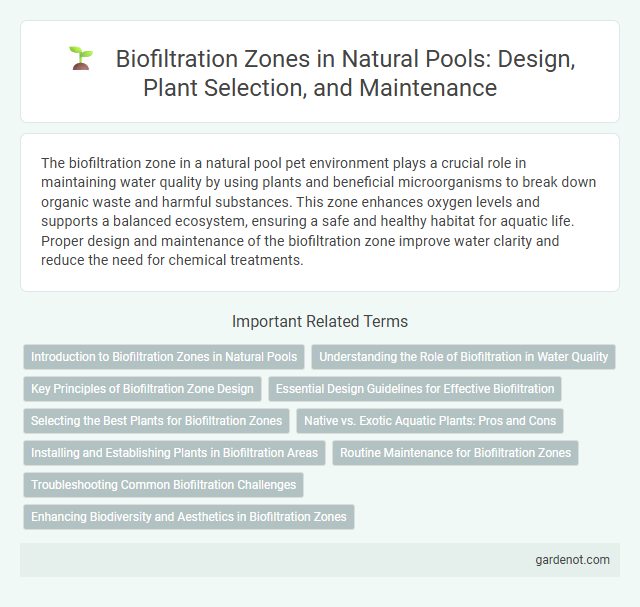The biofiltration zone in a natural pool pet environment plays a crucial role in maintaining water quality by using plants and beneficial microorganisms to break down organic waste and harmful substances. This zone enhances oxygen levels and supports a balanced ecosystem, ensuring a safe and healthy habitat for aquatic life. Proper design and maintenance of the biofiltration zone improve water clarity and reduce the need for chemical treatments.
Introduction to Biofiltration Zones in Natural Pools
Biofiltration zones in natural pools function as essential filtration areas where aquatic plants and beneficial microorganisms cleanse the water by absorbing nutrients and breaking down contaminants. These zones optimize water clarity and balance by harnessing natural biological processes, reducing the need for chemical treatments. Efficient biofiltration zones promote a healthy ecosystem, supporting diverse aquatic life while maintaining sustainable water quality.
Understanding the Role of Biofiltration in Water Quality
The biofiltration zone in a natural pool plays a critical role in maintaining water quality by harnessing beneficial microorganisms and aquatic plants to break down organic matter and filter out pollutants. This biological filtration system reduces the need for chemical treatments by naturally balancing nutrient levels and preventing algae growth, ensuring clear and healthy water. Effective biofiltration enhances oxygenation and supports a diverse ecosystem, promoting sustainable water purification through natural processes.
Key Principles of Biofiltration Zone Design
The biofiltration zone in a natural pool operates on the key principles of biological filtration, mechanical filtration, and nutrient absorption by plants and microorganisms. Designing this zone requires optimizing water flow through porous substrates to maximize contact with biofilms that break down contaminants and utilize natural materials like gravel and sand for effective filtration. Integrating diverse aquatic plants enhances the removal of nitrogen and phosphorus, ensuring balanced water quality and ecological stability.
Essential Design Guidelines for Effective Biofiltration
The biofiltration zone in a natural pool must incorporate permeable substrates such as gravel and sand to support diverse microbial communities that break down organic matter and contaminants. Maintaining a shallow depth of 30-50 cm maximizes oxygen exchange and plant root exposure, essential for nutrient uptake and water clarity. Strategic planting of emergent vegetation with extensive root systems enhances filtration efficiency and stabilizes sediment within the zone.
Selecting the Best Plants for Biofiltration Zones
Choosing the best plants for biofiltration zones in natural pools is crucial for maintaining water quality and ecological balance. Emergent species such as cattails (Typha latifolia), water irises (Iris pseudacorus), and bulrushes (Schoenoplectus spp.) excel at nutrient uptake and provide habitat for beneficial microorganisms. Selecting native, robust plants with high filtration capacity ensures efficient removal of pollutants and supports a sustainable, clear-water ecosystem.
Native vs. Exotic Aquatic Plants: Pros and Cons
Native aquatic plants in the biofiltration zone enhance water quality by supporting local ecosystems and improving nutrient uptake, whereas exotic species may offer rapid growth and unique aesthetics but risk invasive behavior that can disrupt native biodiversity. Selecting native plants minimizes maintenance and promotes balanced microbial activity essential for effective biofiltration in natural pools. However, carefully managed exotic species can complement the filtration process if monitored to prevent ecological imbalance.
Installing and Establishing Plants in Biofiltration Areas
Installing and establishing plants in biofiltration zones involves selecting native aquatic species with high nutrient uptake efficiency to enhance water purification. Proper planting density and substrate preparation ensure robust root development, optimizing microbial activity for effective biofiltration. Seasonal monitoring and adaptive management support plant health and maintain the ecological balance within natural pool biofiltration areas.
Routine Maintenance for Biofiltration Zones
Routine maintenance of biofiltration zones in natural pools involves regular removal of accumulated debris and organic matter to ensure optimal water flow and filtration efficiency. Periodic inspection and pruning of aquatic plants prevent overgrowth, promoting healthy microbial activity that naturally purifies the water. Maintaining balanced nutrient levels and avoiding chemical contaminants support the biofiltration zone's capacity to sustain clear, toxin-free water.
Troubleshooting Common Biofiltration Challenges
Biofiltration zones in natural pools often face challenges such as clogging, imbalance of microbial communities, and inadequate water flow. Regular maintenance, including removing accumulated debris and optimizing plant selection, enhances filtration efficiency and prevents stagnation. Monitoring nutrient levels and adjusting hydraulic retention time helps maintain a healthy biofilter and promotes clear, clean water.
Enhancing Biodiversity and Aesthetics in Biofiltration Zones
Biofiltration zones in natural pools enhance biodiversity by creating habitats for diverse aquatic plants and microorganisms that naturally filter and purify water. Integrating native vegetation supports local wildlife and improves water quality through bioactive processes. Designing these zones with varied plant species and natural stone elements elevates aesthetic appeal while sustaining ecological balance.
Biofiltration zone Infographic

 gardenot.com
gardenot.com